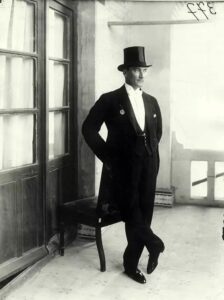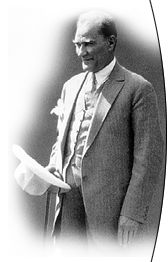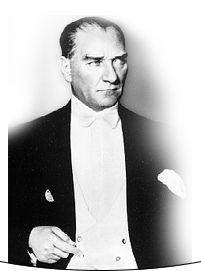Mustafa Kemal Atatürk was born in 1881 in Thessaloniki, Kocakasim District, in a three-storey pink house on Islahhane Street. His father is Ali Rıza Efendi and his mother is Zübeyde Hanım. His paternal grandfather Hafız Ahmet Efendi XIV-XV. It is one of the Kocacık nomads settled in Macedonia from Konya and Aydın in the centuries. His mother, Zübeyde Hanım, is the daughter of an old Turkish family settled in the town of Langaza, near Thessaloniki. Ali Rıza Efendi, who was a militia officer, clerk of foundations and a timber trader, married Zübeyde Hanım in 1871. Four of Atatürk’s five siblings died at a young age, only Makbule (Atadan) lived until 1956.
When little Mustafa reached the age of education, he started his education in the neighborhood school of Hafız Mehmet Efendi, then at his father’s request he transferred to Şemsi Efendi School. Meanwhile, he lost his father (1888). After staying with his uncle in Rapla Farm for a while, he returned to Thessaloniki and finished his school. He enrolled in Thessaloniki Civil High School. After a short time, he entered the Military Junior High School in 1893. In this school, the mathematics teacher Mustafa Bey added “Kemal” to his name. He graduated from the Manastır Military High School in 1896-1899 and started his education at the Military Academy in Istanbul. He graduated with the rank of lieutenant in 1902. He attended the Military Academy. He completed the Academy with the rank of captain on January 11, 1905. Between 1905-1907, he served in Damascus under the command of the 5th Army. He became Kolağası (Senior Captain) in 1907. Monastery III. He was assigned to the army. He served as Chief of Staff in the Movement Army, which entered Istanbul on April 19, 1909. In 1910 he was sent to France. He participated in the Picardie Maneuvers. In 1911, he started to work under the command of the General Staff in Istanbul.

In the war that started with the Italian attack on Tripoli in 1911, Mustafa Kemal took charge in the Tobruk and Derne regions with a group of his friends. He won the Battle of Tobruk against the Italians on December 22, 1911. He was appointed Derne Commander on 6 March 1912.
When the Balkan War started in October 1912, Mustafa Kemal joined the war with the troops in Gallipoli and Bolayır. His great services were seen in the recapture of Dimetoka and Edirne. In 1913 he was appointed Attaché of Sofia. While in this position, he was promoted to lieutenant colonel in 1914. His military attaché ended in January 1915. Meanwhile, World War I started and the Ottoman Empire had to enter the war. Mustafa Kemal was assigned to Tekirdag to establish the 19th Division.
During the First World War, which started in 1914, Mustafa Kemal wrote a heroic epic in Çanakkale and made the Entente Powers say “Canakkale is impassable!” When the British and French navies, trying to cross the Dardanelles on March 18, 1915, suffered heavy losses, they decided to land troops on the Gallipoli Peninsula. The 19th Division commanded by Mustafa Kemal stopped the enemy forces that landed on Arıburnu on April 25, 1915 at Conkbayırı. Upon this success, Mustafa Kemal was promoted to the rank of colonel. The British attacked again at Arıburnu on 6-7 August 1915.Anafartalar Group Commander Mustafa Kemal won the Anafartalar Victory on 9-10 August. This victory on 17 August Kireçtepe, 21 August II. Anafartalar followed the victories. The Turkish nation, which gave 253,000 martyrs in the Dardanelles Wars, knew how to protect its honor against the Entente Powers. Mustafa Kemal’s soldiers said, “I am not ordering you to attack, I am ordering you to die!” The order changed the fate of the front.

Mustafa Kemal took charge in Edirne and Diyarbakir in 1916 after the Dardanelles Wars. He was promoted to major general on April 1, 1916. He fought the Russian forces and ensured the recapture of Muş and Bitlis. After his short assignments in Damascus and Aleppo, he came to Istanbul in 1917. He went to Germany with Velihat Vahidettin Efendi and made investigations at the front. He fell ill after this trip. He went to Vienna and Karisbad for treatment. He returned to Aleppo on 15 August 1918 as the Commander of the 7th Army. He fought successful defensive battles against British forces on this front. One day after the signing of the Armistice of Mudros, he was appointed as the Commander of the Yıldırım Army Group on October 31, 1918. Upon the abolition of this army, he came to Istanbul on 13 November 1918 and started to work at the Ministry of War.
After the Armistice of Mudros, the Allied Powers began to occupy the Ottoman lands; Mustafa Kemal landed in Samsun on 19 May 1919 as the 9th Army Inspector. With the circular published in Amasya on 22 June 1919, he declared that “the nation’s determination and decision will save the nation’s independence,” and called the Sivas Congress to a meeting. He convened the Erzurum Congress between July 23 and August 7, 1919 and the Sivas Congress between September 4 and 11, 1919, and determined the path to be followed for the liberation of the homeland. He was greeted enthusiastically in Ankara on 27 December 1919. With the opening of the Turkish Grand National Assembly on April 23, 1920, an important step was taken towards the establishment of the Turkish Republic.
The Turkish War of Independence began on May 15, 1919, when the first bullet was fired at the enemy during the Greek occupation of Izmir. By signing the Treaty of Sèvres on August 10, 1920, the war was fought with the militia forces called Kuva-yi Milliye against the victorious states of the First World War, which divided the Ottoman Empire between them. The Turkish Grand National Assembly established the regular army, the Kuvâ-yi Milliye – the army was integrated and ended the war with victory.
The important stages of the Turkish War of Independence under Mustafa Kemal are as follows:
- The liberation of Sarıkamış (September 20, 1920), Kars (October 30, 1920) and Gyumri (November 7, 1920).
- Cukurova, Gazi Antep, Kahraman Maras Sanli Urfa defenses (1919-1921)
- 1. İnönü Victory (6 -10 January 1921)
- 2. İnönü Victory (23 March-1 April 1921)
- Sakarya Victory (23 August-13 September 1921)
- The Great Offensive, the Battle of the Commander-in-Chief and the Great Victory (26 August 9 September 1922)
After the Sakarya Victory, on September 19, 1921, the Turkish Grand National Assembly gave Mustafa Kemal the rank of Marshal and the title of Gazi. The War of Independence ended with the Treaty of Lausanne signed on July 24, 1923. Thus, there were no obstacles left for the establishment of a new Turkish state based on national unity on the territory of Turkey, which was shattered by the Treaty of Sèvres and a homeland of 5-6 provinces was left to the Turks.
The establishment of the Turkish Republic was heralded with the opening of the Turkish Grand National Assembly on April 23, 1920 in Ankara. The successful management of the Turkish War of Independence by the Assembly accelerated the establishment of the new Turkish state. On November 1, 1922, the caliphate and the sultanate were separated from each other and the sultanate was abolished. Thus, administrative ties with the Ottoman Empire were severed. On 13 October 1923, the administration of the Republic was accepted, and Atatürk was unanimously elected as the first president. The first government of the Republic was formed by İsmet İnönü on 30 October 1923. The Republic of Turkey began to rise on the foundations of “Sovereignty unconditionally belongs to the nation” and “Peace at home, peace in the world”.

Atatürk made a series of revolutions in order to “raise Turkey to the level of contemporary civilization”. These revolutions can be grouped under five headings:
Political Revolutions:
- Abolition of the Sultanate (1 November 1922)
- Proclamation of the Republic (29 October 1923)
- Abolition of the Caliphate (3 March 1924)
Social Revolutions:
- Giving women equal rights with men (1926-1934)
- Hat and dress revolution (25 November 1925)
- Closure of dervish lodges and tombs (30 November 1925)
- Surname law (21 June 1934)
- Abolition of nicknames and titles (26 November 1934)
- Adoption of international clocks, calendars and measures of length (1925-1931)
Legal Revolution:
- Abolition of the Mecelle (1924-1937)
- Transition to the secular legal order by enacting the Turkish Civil Code and other laws (1924-1937)
Revolutions in Education and Culture:
- Unification of teaching (March 3, 1924)
- Adoption of new Turkish letters (1 November 1928)
- Establishment of Turkish Language and History Institutions (1931-1932)
- Organization of university education (31 May 1933)
- Innovations in fine arts
Revolutions in Economics:
- Removal of tithe
- Encourage the farmer
- Establishment of sample farms
- Establishment of industrial establishments by enacting the Industry Encouragement Law
- I. and II. Implementation of the Development Plans (1933-1937), equipping the country with new roads

In accordance with the Surname Law, Mustafa Kemal was given the surname “Atatürk” on 24 November 1934 by the Turkish Grand National Assembly.
Atatürk was elected as the Speaker of the Turkish Grand National Assembly on April 24, 1920 and August 13, 1923. This presidency was at the level of Head of State-Government. The Republic was proclaimed on October 29, 1923 and Atatürk was elected as the first president. In accordance with the Constitution, presidential elections were renewed every four years. In 1927, 1931 and 1935, the Turkish Grand National Assembly re-elected Atatürk as the President.
Atatürk went on country tours frequently and supervised the work of the state on site. He gave orders to those concerned about the failing aspects. It hosted the heads of state, prime ministers, ministers and commanders of foreign countries visiting Turkey in the capacity of President.
He gave his great speech on 15-20 October 1927 about the War of Independence and the establishment of the Republic, and his 10th Year Speech on 29 October 1933.
Atatürk lived in simplicity in his private life. He married Latife Hanım on 29 January 1923. They went on many country tours together. This marriage lasted until 5 August 1925. Atatürk, who loved children very much, adopted daughters named Afet (İnan), Sabiha (Gökçen), Fikriye, Ülkü, Nebile, Rukiye, Zehra and a shepherd named Mustafa. He took the children named Abdurrahim and İhsan under his protection. He prepared a good future for his living.
In 1937, he donated his farms to the treasury and some of his immovables to Ankara and Bursa Municipalities. He allocated a share of his inheritance to his sister, adopted children, and Turkish Language and History Institutions. She loved reading, listening to music, dancing, horseback riding and swimming. He was extremely interested in Zeybek dances, wrestling and Rumelian folk songs. He enjoyed playing backgammon and billiards. He greatly valued his dog, Fox, with his horse named Sakarya. He had a rich library. He would invite statesmen, scientists, artists to dinners and discuss the problems of the country. He used to wear clean and proper. He loved nature very much. He often went to Atatürk Forest Farm and personally participated in the work.
He spoke French and German. On 10 November 1938, at 9.05 am, he could not recover from the cirrhosis he had contracted and died in Dolmabahçe Palace in Istanbul. His body was buried in Ankara Ethnography Museum, which is his temporary resting place, with a ceremony on 21 November 1938. After the mausoleum was built, his body was buried in his final resting place on November 10, 1953 with a magnificent ceremony.







